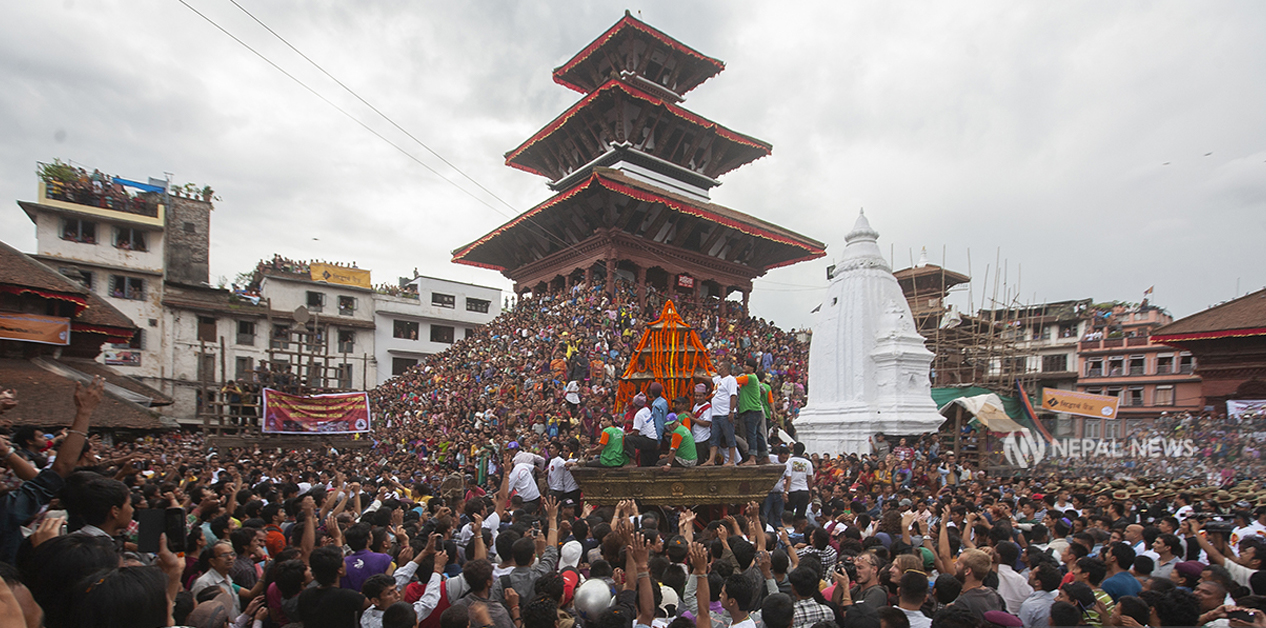
Non-Newars in Kathmandu embrace the language, art, and culture of the Valley

When journalist Prabhat Rimal was born, a family astrologer reportedly told his father, “Sell this child, do not raise him.” Following this advice, Prabhat was “sold” to the family of Ratnaman Dangol for Rs 0.05 (five paisa). Born after three elder sisters and the death of a previous son, Prabhat was sent to another household to avoid misfortune. Growing up in the Hanuman Dhoka area, the heart of the Newar community, he became immersed in Newar culture from an early age, a connection that remains strong today.
For Prabhat, speaking Nepal Bhasa (Newari language) became natural. He has hosted radio programs in the language and sung for the band Newa Beatles. Conversing in Nepal Bhasa with other non-Newars in the valley feels ordinary to him.
“My neighbor is a Magar. We talk in Nepal Bhasa. Many of my friends are local Muslims, Madhesi Brahmins, Marwaris, or Christians, and we communicate in Newar as well,” he says.
He traces his ancestry back 14–15 generations from Achham, Gorkha, and Nuwakot into Kathmandu. Like Prabhat, people from various ethnic, religious, and cultural backgrounds gradually arrived in the valley over time and have since integrated into its culture.
One example is Sampurna Mishra, born into a Madhesi-Brahmin family whose ancestors migrated from the Terai. Her birth home was in Tikshhugalli, Lalitpur, and after marriage, she moved to her husband’s home in Lagantol, Kathmandu. Neighbors, whether in Lalitpur or Kathmandu, were always Newars.
As a health volunteer, she visits many homes and communicates in Nepal Bhasa with locals. Her father, Madan Mohan Mishra, was a renowned writer in both Nepali and Nepal Bhasa. One of his notable works in Nepal Bhasa is Gajiguluya Mhagsay Pashupatinath (1975), meaning “Pashupatinath in the Dream of a Cannabis User.”
Another artist, Hridayaprasad Mishra, lives in Yatkha, Indra Chowk. A Maithili-Brahmin, he is fluent in Nepal Bhasa and is known for portraying the Newar character “Dekha Sahu” in the TV series Tito Satya. His family has lived in Kathmandu for 12–13 generations.
He notes that Madhesi Brahmins historically settled around Hanuman Dhoka, Dhoka Tol, Yatkha, and Sohra Khutte. There are approximately 125 indigenous Madhesi-Brahmin households in the valley, dating back to the Licchhavi period. “In Bhaktapur, places like Intache, Balkhu, Itani, and Patan’s Mangal Bazaar and Mahapal were our traditional settlements,” he adds.
Despite diverse geographical and cultural origins, many non-Newars have adopted Newar customs, language, and festivals. Stories of ethnic, religious, and linguistic coexistence are found throughout the valley’s history.
Scholars, both Nepali and foreign, have studied the arrival and integration of various groups over different historical periods. Some arrived from the north, some from the south; some from hills, others from plains; some for trade, some for war, and others for religious purposes. Groups such as Khas, Buddhist, Muslim, Marwari, and Christian communities eventually settled and blended into Kathmandu’s society.
Although Nepal is geographically isolated, Kathmandu has historically been a dynamic hub for trade, language, economy, and religion, with connections extending from Tibet, China, India, to the Gulf.
Its geography preserved Buddhist traditions while supporting long-term trade between Eastern India and Tibet. Scholars like Prayagraj Sharma note that the Licchhavi-era economy evolved into a commerce-based system over time, making Kathmandu both prosperous and culturally tolerant. Analyst Rajendra Maharjan says, “This made Kathmandu prosperous on one hand, and tolerant on the other.”
Kathmandu’s temples reveal a unique Hindu-Buddhist fusion, while its diverse festivals reflect the interplay between individuals, families, and society. Important local festivals include Indra Jatra, the Rato Machhindranath Jatra, Seto Machhindranath Jatra, and Bhoto Jatra, in which non-Newars actively participate.
For example, Abdul Samim, chairperson of the 500-year-old Jam-e-Masjid (Mosque) in Baghbazar, recalls pulling chariots with Newar friends during childhood. He exchanges festive greetings with friends from multiple communities, reflecting the valley’s spirit of brotherhood.
Abdul enjoys visiting Newar households, where meals may be vegetarian or include halal meat. “I don’t eat meat just because it’s halal,” he explains, “but my Newar sisters know what I prefer and prepare it accordingly. That is respect and love.”
He was raised by a Newar woman from the neighborhood and proudly identifies as a Newar-Muslim. Families like his and the Munna Sheikh family have lived in Baghbazar for generations.
Sampurna emphasizes how cultural exchange has facilitated the integration of non-Newars into Newar traditions. She continues to prepare traditional Newar foods like yomari and offerings for Dashain while maintaining her Maithili heritage.
“We celebrate Indra Jatra, Dhani Purnima, Makar Sankranti, but never abandon our Maithili traditions,” she says. Non-Newars often play decisive roles in festivals, serving as priests or organizers. Many temple rituals in the valley are conducted by Maithili Brahmin priests.
Known as “Katha Bhanne Baje”, Hridayaprasad Mishra gives religious discourses in Nepal Bhasa throughout the valley. On every full moon, rituals at Pashupatinath involve offerings prepared exclusively by Maithili-Brahmin priests.
Similarly, in Basantapur’s Makhan Mahadev and Radhakrishna temples, Maithili priests conduct rituals. Madhesi-Brahmins and Marwaris are also found organizing chariot festivals.
Newar guthis (traditional Newar community-based socio-religious institutions) have historically coordinated festivals and rituals, fostering social cohesion through shared meals and celebrations.
Prabhat notes, “I was drawn to Newar culture partly because of their extraordinary communal feasts. Brahmin gatherings are simple, but Newar feasts involve music, food, and drink, which captivated me.”
Religious and festival rituals require participation across castes and professions, reflecting Newar civilization’s embedded social coexistence. It is said that the more one embraces the cultures of others in social life, the more civilized one becomes and feels at home anywhere. This may well be the defining feature of Newar civilization.